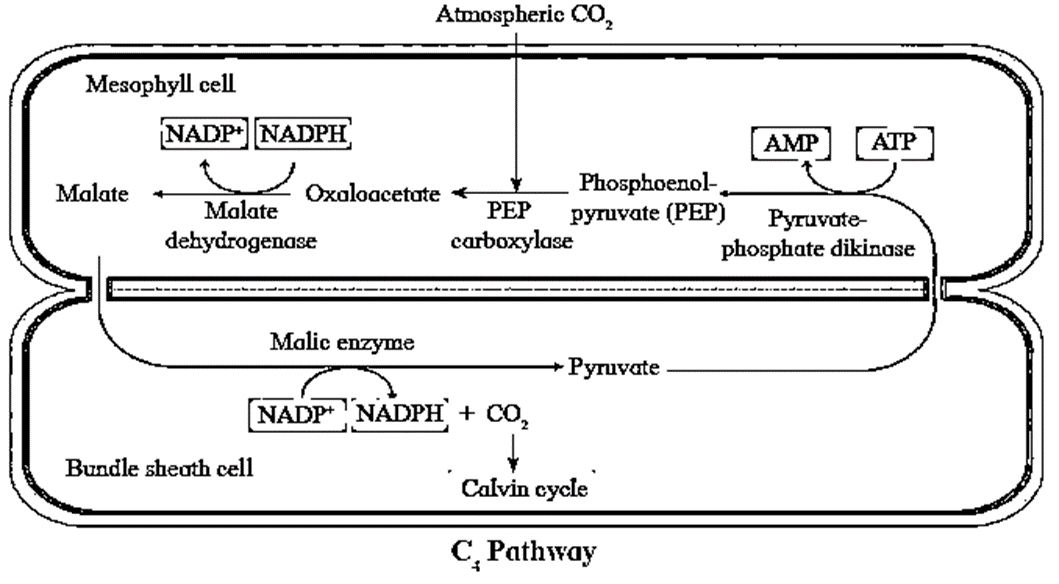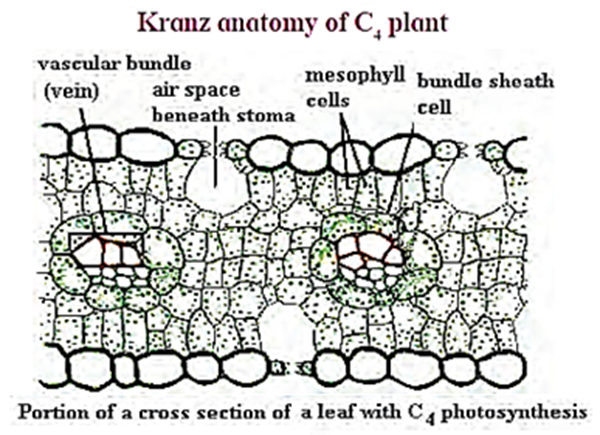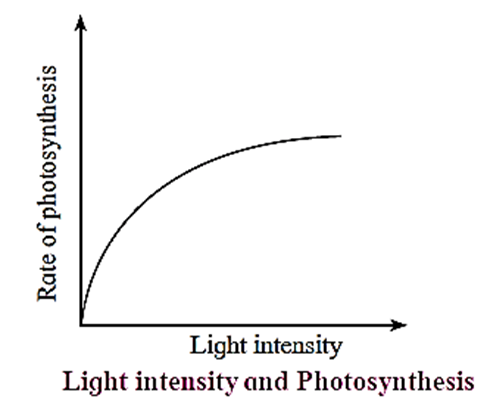Photosynthesis
Maharashtra Board-Class-11-Science-Biology-Chapter-12
Notes-Part-2
Topics to be Learn : Part-2
|
Dark reaction :
- Carbon fixation occurs in the stroma by a series of enzyme catalyzed steps. The enzymes that catalyze the dark reactions of carbon fixation are located outside the thylakoids.
- Molecules of ATP and NADPH produced in the thylakoids (light reaction) come in the stroma where carbohydrates are synthesized.
- The path of carbon fixation in dark reaction through intermediate compounds leading to the formation of sugar and starch.
- Dr. Melvin Calvin and his colleague, Dr. Benson, traced this entire process of the dark response.
- As a result, the process is known as the Calvin cycle or the Calvin-Benson cycle. Because the first stable product generated is a 3-carbon molecule, the system is also known as the C3 pathway, and the plants are known as C3 plants.
- Calvin conducted research on unicellular green algae (Chlorella) using the radioactive carbon isotope C14 as a tracer.
- It is also called synthesis phase or second phase of photosynthesis.
- Calvin cycle is also known as the biochemical phase, because in this phase, the chemical form of energy, i.e. ATP is converted into the biological form, i. e. Glucose.
- Calvin observed that the biochemical reactions that lead to the formation of glucose occurs in a cyclic manner;
The cycle is divided into the following phases:
(i) Carboxylation phase:
- Carbon dioxide reduction starts with a five-carbon sugar ribulose-1, 5-bisphosphate (RuBP). It is a 5-carbon sugar with two phosphate groups attached to it.
- RuBP reacts with CO2 to produce an unstable 6 carbon intermediate in the presence of Rubisco.
- It immediately splits into 3 carbon compounds called 3-phosphoglyceric acid.
- Rubisco is a large protein molecule and comprises 16% of the chloroplast proteins.

(ii) Glycolytic reversal:
- 3-phosphoglyceric acid form 1,3-diphosphoglyceric acid by utilizing ATP molecule.
- These are then reduced to glyceraldchydc-3-phosphate (3-PGA) by NADPH supplied by the light reactions of photosynthesis.
- In order to keep Calvin cycle continuously running there must be sufficient number of RuBP and regular supply of ATP and NADPH.
- Out of 12 molecules of 3-phosphoglyceraldehyde, two molecules are used for synthesis of one glucose molecule.
(iii) Regeneration of RuBP:
- 10 molecules of 3-phosphoglyceraldehyde are used for the regeneration of 6 molecules of RuBP at the cost of 6 ATP.
- Therefore, six turns of Calvin cycle are needed to get one molecule of glucose.
- Thus, RUBP (the initial acceptor), which is necessary for the reduction of CO3, is regenerated to keep the process going.
Thus Calvin cycle regenerates ADP and NADP required for the light reaction
Light Reaction (in granum) :
- 24H2O →24OH- + 24H+
- 24OH- → 24OH + 24e-
- 24e- + 24H+ + 12NADP+ → 12NADPH
- 18ADP + 18Pi →18ATP
- 24OH → 12H2O + 6O2 ↑
Dark reaction (in stroma) :
- 6CO2 + 18ATP + 12NADPH → C6H12O6 + 6H2O + 18ADP + 18Pi + 12NADP+
- (i + ii) 6CO2 + 24H2O \(\frac{Sunlight}{Chloroplast}\) C6H12O6 + 18H2O + 6O2 ↑
Significance of each pahse :
- Carboxylation: RuBisCO is the most abundant enzymes in the world. It is responsible for fixing carbon in the form of CO2 into sugar.
- Reduction: NADPH2 donates electrons to 1,3-Bisphoshoglycerate to form 3-phosphoglyceraldehyde molecules.
- Regeneration: Some 3-phosphoglyceraldehyde molecules are involved in production of glucose while others are recycled to regenerate the 5-carbon compound RuBP which used to accept new carbon molecules.
Photorespiration :
Photorespiration occurs in situations such as high temperature, bright light, high oxygen concentration, and low CO2 concentration. It is a wasteful process associated with the C3-Cycle, in which CO2 is released rather than fixed.
Process of photorespiration Mechanism:
Photorespiration involves three organelles, chloroplast, peroxisomes, and mitochondria, and takes place in a sequence of cyclic reactions known as the PCO cycle. (Cycle of Photosynthetic Carbon)

- At increased O2 concentrations, the enzyme Rubisco works as an oxygenase, and photorespiration occurs.
- When RuBP reacts with O2 rather than CO2 to form a 3-carbon compound (PGA) and 2-carbon compound phosphoglycolate.
- Phosphoglycolate is then converted to glycolate which is shuttled out of the chloroplast into the peroxisomes.
- In Peroxisomes, glycolate is converted into glyoxylate by enzyme glycolate oxidase.
- Glyoxylate is further converted into amino acid glycine by transamination.
- In mitochondria, two molecules of glycine are convened into serine (amino acid) and CO2 is given out.
- Thus, it loses 25% of photosynthetically fixed carbon.
- Serine is transported back to peroxisomes and converted into glycerate.
- It is shuttled back to chloroplast to undergo phosphorylation and utilized in formation of 3-PGA, which get utilized in C3 pathway.
- The process of photorespiration generally occurs in temperate plants.
- Photorespiration occurs when the CO2 level inside a leaf becomes very low (~ 50ppm).
C4 pathway or Hatch-Slack pathway :
- M. D. Hatch and C. R. Slack while working on sugarcane found four carbon compounds (dicarboxylic acid) as the first stable product of photosynthesis.
- It occurs in tropical and sub-tropical grasses and some dicotyledons. '
- The first product of this cycle is a 4-carbon compound oxaloacetic acid. Hence it is also called as C4 pathway and plants are called C4 plants.
Mechanism:
- CO2 taken from atmosphere is accepted by a 3-carbon compound, phosphoenolpyruvic acid in the chloroplasts of mesophyll cells, leading to the formation of 4-C compound, oxaloacetic acid with the help of enzyme phosphoenolpyruvate Carboxylase.
- It is converted to another 4-C compound, malic acid.
- It is transported to the chloroplasts of bundle sheath cells.
- Malic acid (4-C) is converted to pyruvic acid (3-C) with the release of CO2 in the cytoplasm.
- Thus, concentration of CO2 increases in the bundle sheath cells.
- Chloroplasts of these cells contain enzymes of Calvin cycle.
- Because of high concentration of CO2, RuBP carboxylase participates in Calvin cycle and not photorespiration.
- Sugar formed in Calvin cycle is transported into the phloem.
- Pyruvic acid generated in the bundle sheath cells re-enter mesophyll cells and regenerates phosphoenolpyruvic acid by consuming one ATP.
- Since this conversion results in the formation of AMP (not ADP), two ATP are required to regenerate ATP from AMP.
- Thus, C4 pathway needs 12 additional ATP.
- The C3 pathway requires 18 ATP for the synthesis of one glucose molecule, whereas C4 pathway requires 30 ATP. Thus, C4 plants are better photosynthesizers and there is no photorespiration in these plants.

C4 plants have high productivity :
Reason :
- C4 plants have a high value of net assimilation at high temperatures.
- Their rate of carbon assimilation is quite rapid.
- C4 plants perform photosynthesis even when stomata are closed as PEP has high affinity for CO2
- Photorespiration is considered to be a wasteful process in plants. It is an energy consuming process in plants which ultimately leads to reduction in final yield of plants.
- During C3 photosynthesis-, 25% of the carbon dioxide fixed has to pass through photorespiratory process.
- This decreases the photosynthetic productivity.
- In C4 plants, photorespiration is absent and hence they have better productivity.
Kranz anatomy :
Functional significance :
Leaves of C4 plants show some structural peculiarities called Kranz anatomy. This helps the plant in efficient assimilation of atmospheric carbon dioxide.

The mesophyll of the leaf is undifferentiated, i.e. all the cells are of one type -and are compactly arranged.
Vascular bundles are surrounded radially arranged large bundle sheath cells.
Chloroplasts are dimorphic, i.e. of two types:
- Chloroplasts of mesophyll cells are smaller, more in number and are abundant with grana, contain a very little stroma and are arranged centrifugally.
- Chloroplasts of bundle sheath cells are larger, less in number and are without grana, only with stroma and arranged centripetally.
Kranz anatomy prevents photorespiration in C4 plants.
Differentiate between C3 and C4 plants :
| C3 plants | C4 plants |
| These plants are mostly temperate plants. | These are mostly tropical and subtropical plants. |
| Leaves do not show Kranz anatomy. | Leaves show Kranz anatomy. |
| Mesophyll tissue is made up of palisade and spongy tissue. | Mesophyll tissue is made up of only spongy tissue. |
| Chloroplast is of only one type. | Chloroplasts are of two types (dimorphic). |
| Plants absorb CO2 at high concentration only (more than 50ppm). | Plants absorb CO2, even at low concentration (1-2ppm). |
| Rate of photosynthesis and productivity is less. | Rate of photosynthesis and productivity is high. |
| Excess of atmospheric O2 inhibits photosynthetic activity. | Excess of atmospheric O2 has no effect on Photosynthesis. |
| e.g. Hibiscus, sunflower, wheat, rice, potato, etc. | e.g. Sugarcane, maize, jowar, Amaranthus, etc. |
CAM-Crassulacean Acid Metabolism:
- It is one more alternative pathway of carbon fixation found in desert plants.
- It was first reported in the family Crassulaceae, therefore called as CAM (Crassulacean Acid Metabolism).
- In CAM plants, stomata are scotoactive i.e. active during night, hence initial CO2 fixation occurs in night.
- Thus, C4 pathway fix CO2 at night and reduce CO2 in day time via the C3 pathway by using NADPH formed during the day.
- PEP caboxylase and Rubisco are present in the mesophyll cell (no Kranz anatomy).
- Formation of malic acid during dark is called acidification (phase I).
- Malate is stored in vacuoles during the night.
- Malate releases CO2 during the day for C3 pathway within the same cell is called deacidification (phase II).
- Examples of CAM plants: Kalanchoe, Opuntia, Aloe etc.
- The Chemical reactions of the carbon dioxide fixation and its assimilation are similar to that of C4 plants.

- Thus in CAM plant during night time, organic acid concentration of succulents increases and during day time, it decreases to almost zero. This day and night fluctuation in acid concentration is an essential feature of CAM plant.
- Kranz anatomy is absent in CAM plants. These are mostly xerophytic plants.
Q. Xerophytic plants survive in high temperature. How?
- Xerophytic plants are those that have adapted to dry environments.
- They have adapted to arid conditions by storing water in stems.
- They are the drought resistant plants. They have reduced the rate of transpiration to bare minimum.
- Leaves are modified into spines or are reduced in size to check the loss of water due to transpiration
- The waxy surfaces of xerophytic plants prevent the loss of moisture.
- Thus they are able to survive in high temperature.
Factors affecting Photosynthesis :
Like all other physiological processes, photosynthesis is also influenced by a number of factors.
(A) External Factors :
(i) Light :
- It is a crucial element because it provides the energy required for photosynthesis.
- Light's colour and intensity have an impact on photosynthesis.
- Photosynthesis occurs most quickly in red light, then in blue light.
- When a forest canopy is present, photosynthesis rates in plants significantly decrease.
- The majority of plants are most capable of photosynthesis in bright, diffused sunshine.
- Without causing the plant any obvious harm, uninterrupted and continuous photosynthesis can be continued for a very long time.
(ii) Carbon dioxide:
- The main source of CO2 in land plants is the atmosphere, which contains only 0.3% of the gas.
- Under normal conditions of temperature and light, carbon dioxide acts as a limiting factor in photosynthesis.
- Increase in concentration of CO2 increases the photosynthesis.
- Increase in CO2 to about 1% is advantageous to most of the plants.
- Higher concentration of the gas has an inhibitory effect on photosynthesis.
(iii) Temperature:
- Like all other physiological processes, photosynthesis also needs a suitable temperature.
- The optimum temperature at which the photosynthesis is maximum is 25-30 °C. Except in plants like Opuntia, photosynthesis takes place at as high as 55°C.
- This is the maximum temperature. Minimum temperature is temperature at which photosynthesis process just starts.
- In the presence of sufficient light and CO2, photosynthesis increases with the rise of temperature till it becomes maximum. After that there is a decrease or fall in the rate of the process.
(iv) Water :
- Water is necessary for photosynthetic process.
- An increase in water content of the leaf results in the corresponding increase in the rate of photosynthesis
- Thus, the limiting effect of water is not direct but indirect.
- It is mainly due to the fact that it helps in maintaining the turgidity of the assimilatory cells and the proper hydration of their protoplasm.
(B) Internal Factors :
Internal factors which affects photosynthesis are as follows:
(i) Chlorophyll :
- Though presence of chlorophyll is essential for photosynthesis but rate of photosynthesis is proportional to the quantity of chlorophyll present.
- It is because of the fact that chlorophyll merely acts as a biocatalyst and hence a small quantity is quite enough to maintain the large bulk of the reacting substances.
(ii) Sugar :
- The final product in the photosynthesis reaction is sugar and its accumulation in the cells slow down the process of photosynthesis.
(iii) Internal structures :
- The thickness of cuticle and epidermis of the leaf, the size and distribution of intercellular spaces and the distribution of the stomata and the development of chlorenchyma and other tissues also affects the rate of photosynthesis.
Blackman’s law of limiting factors :
- According to the Blackman's rule of limiting factors, the speed of the "slowest factor" governs the rate of a process when multiple independent elements condition the process's rapidity.
- The law of limiting factor can be explained by using two external elements, such as carbon dioxide and light, as examples.
- The slowest factor is that factor that is present in the lowest or smallest concentration in proportion to others.
- For example, a plant photosynthesizing at a fixed light intensity sufficient to utilize 10mg of CO2 per hour only.
- Photosynthetic rate goes on increasing when concentration of CO2 increases.
- Further increase in CO2 concentration will not increase the rate of photosynthesis. In this case light becomes the limiting factor. Therefore, under such circumstances rate of photosynthesis can be increased only by increasing the light intensity.

- This proves that the rate of photosynthesis responds to one factor alone at a time and there would be a sharp break in the curve and a plateau formed exactly at the point where another factor becomes limiting.
- If any one of the other factors which is kept constant (e.g. Light) is increased, the photosynthetic rate increases again reaching the optimum where again another factor becomes limiting.
Significance of Photosynthesis :
- Photosynthesis is anabolic process which uses inorganic substances and produces food for all life directly or indirectly.
- This process transforms solar energy into chemical energy.
- The released by product O2 is necessary not only for aerobic respiration in living organisms but also used in forming protective ozone layer around earth.
- It also helps us in providing fossil fuels, coals, petroleum and natural gas.
Main Page : – Maharashtra Board Class 11th-Biology – All chapters notes, solutions, videos, test, pdf.
Previous Chapter : Chapter-11- Study of Animal Type : Cockroach – Online Notes
Next Chapter : Chapter-13-Respiration and Energy Transfer – Online Notes
We reply to valid query.